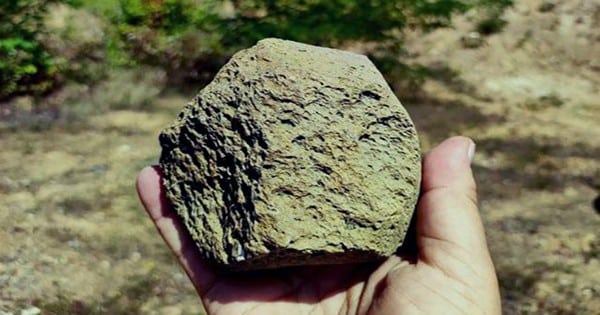During mild times in Earth’s history known as interglacials, glaciers the size of continents receded, exposing new landscapes. These were new worlds for early humans to explore and exploit, and 1.4 million years ago, this was Europe: a Terra nullius, uninhabited by humans.
Long before it became the core of global colonialism, Europe was colonized for the first time by migrants from the East.
A new study, coordinated by a team from the Czech Academy of Sciences and Aarhus University and published this week in Nature, describes the earliest human presence in Europe at Korolevo, a site on the Tysa River in western Ukraine.

Buried stone tools at Korolevo, Ukraine
We investigated a layer of stone tools left on a riverbed by those who made them. These “core-and-flake” artifacts were manufactured in the Oldowan style, the most primitive type of tool-making, which was initially identified by palaeoanthropologist Mary Leakey in East Africa. Similar tools have also been discovered at the oldest known human settlements in Europe, the Levant, and Asia.
The tools at Korolevo had been buried by river sediment, then by wind-blown dust, before being discovered by stone quarry workers. V. N. Gladilin, a Ukrainian archaeologist, uncovered evidence of prehistoric human activity at this site in 1974.
Early attempts to use the tools were difficult. Measurements of leftover magnetism in the overlaying layers revealed that the lowermost artifacts predated the Matuyama-Brunhes reversal, which occurred 0.8 million years ago. This time exceeds the boundaries of generally used dating methods, such as radiocarbon dating (which can go back around 50 thousand years) and luminescence dating (which is often confined to the previous 300 thousand years or so).
A cosmic-ray-based dating method
To tackle this challenge, we used a novel dating method based on cosmogenic nuclides that can go back 5 million years, which is the essential epoch for human evolution. This approach has already produced definitive ages at other major sites, including the 3.4 million-year-old Australopithecus at Sterkfontein in southern Africa and the 0.77 million-year-old Zhoukoudian Homo erectus, also known as “Peking Man.”
It works as follows: exploding stars (supernovae) outside our solar system emit cosmic rays that enter Earth’s upper atmosphere, causing showers of secondary cosmic rays to fall to Earth, where they react with minerals in rocks and soils to produce radioactive nuclides in tiny but measurable quantities.
To determine the burial age, we measured two such nuclides: beryllium-10 and aluminum-26. A date was derived by monitoring the ratio of these two nuclides, which changes over time after burial due to their different radioactive decay half-lives: 1.4 million years for beryllium-10 and 0.7 million years for aluminum-26.
By applying this method to the sediment layer containing the stone tools at Korolevo, we were able to determine a burial age of 1.5 to 1.3 million years (the 1-sigma uncertainty range), making this Europe’s earliest securely dated human habitation.
Who resided in Korolevo?
We can’t determine for certain who these pioneers were because there are no fossils at Korolevo. However, the tools are too old and rudimentary to be created by either anatomically modern people (Homo sapiens) or Neanderthals. The toolmakers were most likely a species of Homo erectus, a spectacularly successful human ancestor who appeared around 2 million years ago and spread over varied ecosystems in Africa, Asia, and Europe.
Early people moved through the Levant region on their way from Africa to Eurasia, leaving evidence of occupancy in Zarqa Valley as early as 2.5 million years ago. Further north, additional Homo erectus fossils going back 1.8 million years have been discovered in Dmanisi, Caucasus Mountains.
Europe colonized from the East
Once in Eurasia, people traveled eastward at a surprising velocity, reaching as far as the island of Java in southeast Asia at the same time they arrived in western Ukraine. It is unknown what prompted the delayed westward advance into Europe, but Korolevo appears to bridge the migration gap between the Caucasus (1.8 million years ago) and sites in southern Europe dating back 1.2 to 1.1 million years at Atapuerca and Vallonnet. One hypothesis is that people arrived in Europe from the east via the Danube Valley and the Pannonian Plain.
What they discovered was drastically different from the present day. Megafauna such as the mammoth, hippopotamus, huge species of hyena, cheetah, beaver, saber-toothed cat, scimitar-toothed cat, and European jaguar—among others that have long since perished from the continent—were present 1.4 million years ago.
Interglacial warmth presented an opportunity
Korolevo is the northernmost known presence of what we believe to be Homo erectus. Our burial age of approximately 1.4 million years ago corresponds to three interglacial eras that were among the warmest in the last few million years. We propose that people use these warm intervals to disperse to higher latitudes.
The intervening glacial eras in this region were extremely cold, eliminating the prospect of a suitable environment for people. We believe that climate had a significant impact on human behavior back then, just as it does today.
Europe’s Origin Story
Our discovery in Ukraine adds a new and unexpected dimension to the tale of Europe. Differing perspectives on the meaning of these ancient artifacts will undoubtedly emerge, not least because their discovery in such a contentious place throws concerns about human history squarely into the geopolitical fray.
However, there is an opposing point of view. It celebrates human achievement and serves as a reminder of the common ground from which all humanity emerged: a salve for overcoming these gloomy times.
















